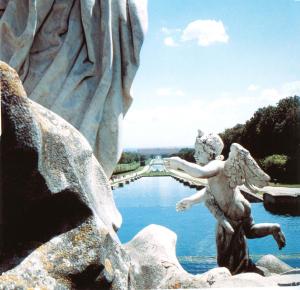
The monumental Palace of Caserta, created by the king Charles of Bourbon during the XVIII century, was built to be a new Versailles, a symbol of the greatness of the new kingdom. The architect of this incredible masterpiece was Luigi Vanvitelli. Charles of Bourbon decided to build that Royal Palace in Caserta because in 1742 the British fleet threatened to bombard Naples to obtain the neutrality of the Kingdom of the two Sicilies in the war of succession for the throne of Austria. It would have been quite easy to shell Naples from the sea: that is the reason why the Bourbon king founded a new capital away from the coast.
Caserta became the new capital of the Kingdom of Naples. Its foundation stone was laid on 20 January 1752 in an official ceremony celebrating the 36th birthday of King Charles. Vanvitelli had presented his project the previous year, on 2 May 1751. Over the years, King Charles personally followed the works together with the Queen and they both were Vanvitelli’s inspirers, however without modifying the original design of the great architect. It was an excellent “union of souls”: evidence of this is given by Vanvitelli himself, in his periodic letters sent to his brother, where he always expressed his joy for the attention that the two Sovereigns paid to his work and for the good understanding that made the work progress quickly and with great profit.
In fact, after the Sovereign left Naples to ascend the throne of Madrid in 1759, things never went as before and Vanvitelli always recalled the happy days of the ‘50s, sometimes with a bitter regret. The situation even worsened when Tanucci took control of the Kingdom and cut the money available to Vanvitelli: in the ‘50s 2000 workers were employed in the construction, but in the ‘60s their number was halved. Then in 1767 Vesuvius lent Vanvitelli a hand: after a violent eruption, the young King Ferdinand IV decided to move the Court from Portici to Caserta and therefore he resumed his work in a more active way. But the conclusion of the works will take place only during the XIX century.
The Palace has been designed as a huge building with twin façades, one facing the parade ground, the other the gardens. The central dome and the statue of Charles on the gable in the middle of the façade were present in the original design but were never realised. In total, the Palace has 1200 rooms, 1742 windows and a garden 3 km long. In 1762 the water from Maddaloni reached the Palace through the Caroline aqueduct. A description of the Palace and its gardens is impossible here.
It is one of the most famous and loved architectural masterpieces in the world. We will limit ourselves to spend a few words on the most important and beautiful rooms. First of all we could mention for their beauty the “Royal Staircase” and the Palatine Chapel (similar to that one in Versailles). The Chapel, in particular, is an unadorned and vaulted room with columns and a high stylobate. It was inaugurated by the Mass of Christmas Eve in 1784, in presence of the King and all the Court. The chapel is dedicated to the Virgin Mary, whose image is painted on the apse. An important room is “The room of Alexander” where during the French domination (1806-1815) the throne of the viceroy Murat was. Very interesting in the same room are also two big paintings representing “The abdication of Charles in favour of his son Ferdinand” by Maldarelli and “Charles at the battle of Velletri” by Camillo Guerra.
Another important room is obviously the Throne one, designed by the architect Genovesi in 1845 where the carved wooden throne lies and all around on the top of the walls 46 medallions represent the various kings of Naples over the centuries.
Worthy of note are also the “Rooms of the Seasons”, small and highly decorated rooms: in the room of “Spring”, the King and Queen welcomed their most intimate guests and Hackert embellished it with some splendid paintings of views of harbours.
Once crossed the three neoclassical rooms of the Palatine Library, we reach the Elliptic Room, all white washed, without decorations, destined to the Court recreation: nowadays it houses the enchanting Bourbon Crib. Bourbon kings always encouraged the ancient Neapolitan tradition of making Cribs and every Christmas a huge crib was prepared in the Palace by expert artisans but also by the Princesses, who tailored the dresses of the shepherds. The hands, heads and feet of the statuettes were made of clay, whereas the body was made of straw and wire.
To conclude, no description can convey the beauty of the wonderful gardens and their enchanting statues, that can only be appreciated personally there. Only by visiting this place we can realise the splendour of the Palace and the munificence of the Bourbons, makers of some of the most beautiful and largest Palaces in the world.